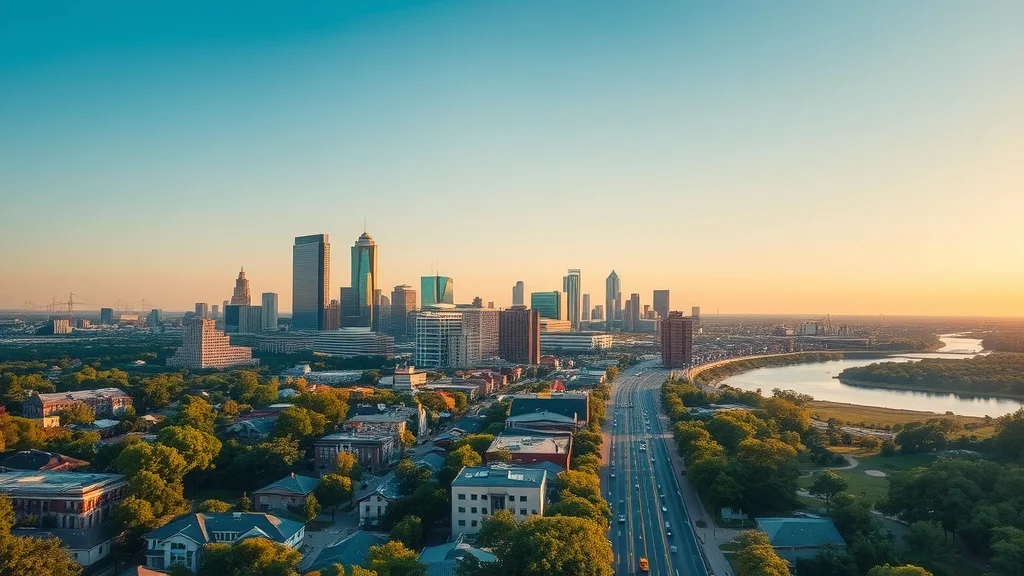Did you know that while much of the U.S. saw home values dip in 2023, Austin’s median sale price actually rebounded faster than any other major Texas city? This surprising trend has sparked a wave of speculation—so, is Austin's real estate and housing market about to skyrocket?
A Surprising Look at Austin's Real Estate and Housing Market Trends in 2024
Austin’s real estate and housing market has always marched to the beat of its own drum. While many U.S. metros saw steady pricing or even slight declines, Austin's unique combination of tech-fueled job growth and surging population has meant home sale activity is picking up once again. In 2024, new research shows that homes in Austin are taking a bit longer to sell compared to the pandemic frenzy, but median sale prices are holding steady. What’s more, Central Texas including Travis County has maintained a healthy level of inventory, even as active listings shift from month to month.
This year's data reveal a fascinating contrast: while national headlines warn of affordability crises, buyers are meeting sellers in Austin at prices that continue to support that confidence. Unlock MLS data indicates a valuable market consistency, with a median sale price up over 5% year-over-year—a sign that homes sold in the region are still attracting robust interest. Interest rate cuts expected later in the year may accelerate activity, but for now, this level of stability sets Austin apart from peer cities. If you’re watching Central Texas for seismic shifts, this could be the moment you’ve been waiting for.

What You'll Learn About Austin's Real Estate and Housing Market
The current status of Austin's real estate and housing market
Critical factors fueling potential growth
Key statistical trends shaping Central Texas and Travis County
Expert opinions and data-driven predictions
Answers to 'People Also Ask' about Austin property
Austin's Real Estate and Housing Market: Setting the Stage
A Startling Statistic: Home Sale Performance vs. National Trends
While the U.S. housing market cooled in 2023 with a dip in both home prices and homes sold, Austin’s real estate and housing market started to buck the trend by early 2024. According to median sale data, Travis County saw a swift recovery with sale prices increasing quicker than Dallas, Houston, or even several West Coast metros. In fact, even as homes may be taking a bit longer to sell—which reflects a return to a pre-pandemic pace—the median sale price growth is outpacing national averages.
"Austin's housing market defies old expectations — what does history say about explosive rebounds?"
This unusual resilience traces back to the city’s fundamentals: sustained growth in jobs, continued net migration, and a healthy level of active listings compared to before the pandemic. Austin’s housing market shows that the market's consistency shows true staying power when compared to markets experiencing dramatic booms and busts. Sellers continues to support that confidence even if buyers have more options in 2024.

Comparison of Austin's Real Estate and Housing Market Metrics vs. Competing Cities (2023-2024) | ||||
City |
Median Sale Price (2024) |
YOY Price Change (%) |
Avg. Days on Market |
Active Listings |
|---|---|---|---|---|
Austin, TX |
$540,000 |
+5.2% |
38 |
8,200 |
Dallas, TX |
$410,000 |
+2.7% |
44 |
10,500 |
Houston, TX |
$355,000 |
+1.9% |
46 |
12,000 |
Phoenix, AZ |
$425,000 |
+1.1% |
52 |
15,300 |
Seattle, WA |
$749,000 |
+3.5% |
36 |
7,100 |
Core Drivers Behind Austin's Real Estate and Housing Market Momentum
Central Texas Economic Expansion and Its Impact on the Housing Market
Central Texas has been a national hotspot for economic development. Austin’s rise as a tech corridor has drawn global attention, with companies both large and small flocking to take advantage of a business-friendly environment. This ongoing growth has directly fueled Austin's real estate and housing market, creating a robust demand for homes in Austin and the greater Travis County area. As more high-paying jobs arrive, home sale activity picks up, and unlock MLS data continually highlights healthy jumps in active listings and home prices.
Key sectors, such as technology, healthcare, and manufacturing, are showing strong expansion, pushing the job market higher and driving property demand. This positive economic climate encourages would-be investors to consider Austin not just for personal housing but also for development and rental opportunities. In short, Central Texas’ growth is laying the foundation for a market that may be on the verge of another upturn, provided that the momentum remains steady.
As Austin continues to evolve, the city’s creative and cultural scene is also flourishing, offering residents a vibrant lifestyle beyond real estate. For a unique perspective on how local artistry is shaping the community, explore the collaborative albums from Brian Eno and Beatie Wolfe, which highlight Austin’s dynamic spirit: discover how music and innovation intersect in the heart of the city.
Migration Trends and Travis County Demographics: A Closer Look
The demographic story of Austin is one of remarkable transformation. Over the past decade, Travis County has become a magnet for young professionals, tech workers, families, and retirees, resulting in steady population growth. This migration trend is more pronounced compared to other Texas counties, including Hays County, Bastrop County, and Caldwell County. Houses in desirable neighborhoods are often in high demand, with many buyers seeking proximity to job centers and vibrant urban amenities.
As a diverse range of newcomers arrive with various housing needs, the dynamics of home sales in Austin shift accordingly. The housing market reflects this by offering everything from luxury condos in the downtown core to family homes on the outskirts. While some first-time buyers may be concerned about affordability, the influx of well-paid transplants has buoyed median sale prices in the area. Notably, this keeps inventory moving and ensures that homes may be taking a bit longer to sell, but transactions remain strong.

Tech Industry Growth and Real Estate Investment Opportunities
Few cities are as synonymous with tech-driven transformation as Austin. What was once a small college town is now the “Silicon Hills,” where giants like Apple, Google, and Tesla are reshaping the city’s employment landscape. The result? Unprecedented demand for both commercial and residential real estate, with rental yields and capital gains in some sectors outpacing the national average.
For savvy investors, the intersection of tech expansion and a surging population presents a unique window of opportunity. Unlock MLS data signals increasing competition for investment properties—particularly in neighborhoods near major employment centers and transit nodes. Even those with limited real estate experience are finding opportunities to build equity as Austin’s market shows remarkable consistency in price trends and a healthy level of stability.
Austin's Real Estate and Housing Market: Emerging Challenges
Affordability Crisis: How Home Sales Are Influenced by Wage Growth
With growth comes complexity, and Austin’s housing market is not immune to affordability pressures. Wage growth, while notable in tech and health sectors, hasn’t always kept pace with the rising median sale price of homes in Austin. This mismatch creates barriers for first-time buyers and middle-income families, especially as mortgage rates remain above pre-pandemic lows. Many find that homes in Austin are taking a bit longer to sell if they are priced at the upper end—reflecting a market in which buyers are more discerning and sometimes stretched thin.
Nonetheless, the new landscape is prompting both buyers and sellers to adjust expectations. Some sellers are responding with modest price corrections—yet the level of stability in median pricing and continued active listings indicate the market retains underlying strength. For now, experts suggest that as long as job growth continues and Central Texas remains economically vibrant, affordability pressures won’t derail the housing market’s upward momentum, but will temper the rate of its advancement.

Inventory Fluctuations in the Housing Market Across Central Texas
Inventory is a key storyline in Austin’s real estate and housing market for 2024. While active listings are well above the historic lows of 2021-2022, they’re still tight compared to pre-pandemic averages. In Hays County, Bastrop County, Travis County, and Caldwell County, available homes can vary sharply from one zip code to the next. This patchwork drives pockets of intense competition, particularly for move-in-ready homes in desirable school districts and with easy access to major employers.
For sellers, the implication is continued leverage over pricing from sellers, helped by the healthy level of buyer demand trickling in from ongoing migration. Buyers, on the other hand, may see homes may be taking a bit longer to find the right match—though unlock MLS figures show picked up slightly in some suburbs. Watching active listings and days on market is essential for anyone seeking a favorable deal amid these ongoing fluctuations.
Market Projections: Is Austin's Housing Market Set for an Explosion?

Expert Forecasts for Austin's Real Estate Market in 2024 and Beyond
Most analysts agree: the ingredients for a market “explosion” are present, but the outcome depends on several interlocking factors. As rate cut discussions intensify, expectations among buyers and sellers in Austin are shifting—from wanting to lock in good deals before prices rise to expecting greater inventory as hesitant sellers finally unfreeze. Expert forecasts suggest median price increases of 5-7% by the end of the year, primarily in high-demand Central Texas neighborhoods.
"Central Texas hasn't seen this combination of optimism and skepticism in decades."
The big wild card? The impact of broader national economic conditions. Should interest rate cuts materialize and migration hold, the Austin’s real estate and housing market could see a surge in home sale volume, with homes in austin moving faster by Q4 2024 into early 2025. But a sudden reversal—such as a tech sector correction—could mean more modest growth or short-term stability instead.
Potential Triggers: What Could Spark a Real Estate Boom in Austin?
Three pivotal factors could ignite an explosive phase in Austin’s market: a sharp drop in mortgage rates, a tech hiring spree, and a wave of returning investors seeking capital gains in fast-rising neighborhoods. Experts indicate that an anticipated rate cut in nine months could drastically lower monthly payments, drawing out both first-time buyers and move-up homeowners.
Another catalyst is urban development, with new infrastructure projects such as Project Connect poised to enhance neighborhood desirability and accessibility. If these projects continue and economic optimism rises, pent-up demand could translate to record home sale numbers—potentially locking in a new era of market expansion across Travis County, Hays County, and central texas suburbs.
People Also Ask: Your Austin Real Estate Questions Answered
Is Austin in a buyers or sellers market?
Austin's Real Estate and Housing Market Buyer vs. Seller Dynamics
For now, Austin remains a moderate seller’s market. While homes may be taking a bit longer to sell than during the height of the pandemic, inventory levels aren’t yet high enough to tip the balance toward buyers. Sellers benefit from continued demand, especially for well-maintained homes in top school districts or close to major employers. That said, buyers now have more choice and power to negotiate—though unlock MLS data shows that the median sale price hasn’t dropped significantly, signaling a healthy level of stability in the region.
Are home prices dropping in Austin, TX?
Price Trends in Austin's Real Estate and Housing Market
Contrary to some reports, home prices in Austin have not seen substantial drops in 2024. While there was a brief cool-down in late 2022 through early 2023, steady demand and limited new supply have kept the median sale price on an upward trajectory. The most current figures indicate a year-over-year increase of around 5-6%. This resilience is attributed to robust job growth, a continual stream of newcomers, and the area’s appeal to out-of-state buyers.
What is the real estate market in Austin 2025?
Austin's Real Estate and Housing Market 2025 Forecast
Looking ahead, experts anticipate moderate yet positive momentum for Austin’s housing market in 2025. If projected rate cuts occur and economic tailwinds remain, the market should see a boost in both sale price and volume. Central Texas is expected to remain a top relocation spot, fueling competition for homes in premium neighborhoods. However, caution is advised due to ongoing challenges with affordability and possible fluctuations in inventory as new developments come online.
Is it smart to buy a house in Austin right now?
Buying in Austin's Real Estate and Housing Market: Risks and Rewards
Purchasing a home in Austin today comes with both opportunities and risks. On one hand, strong fundamentals and ongoing demand suggest prices will hold or climb in the coming years. On the other, buyers should keep an eye on interest rate movements and evaluate their own long-term housing needs versus the possibility of short-term price fluctuations. Many experts believe it’s a smart move for those who intend to settle in Central Texas for several years, especially if they’re willing to be patient and negotiate in the current market climate.
Top Considerations Before Entering Austin's Real Estate and Housing Market
Current mortgage rates and lending climate
Neighborhood growth projections across Central Texas and Travis County
Job market factors driving home sale activity
Quality of life and future urban development

FAQs: Navigating Austin's Real Estate and Housing Market
How does Austin's housing boom compare to other Texas metros?
Austin outpaces most Texas cities in both home price growth and job creation, though Dallas and Houston are closing the gap in some areas. The uniqueness of the tech industry in central texas often propels higher demand.What are the hidden risks for first-time home buyers?
First-time buyers should watch out for hidden costs like property taxes and HOA fees, as well as the risk that rapid appreciation could slow if national economic trends falter.How will continued tech growth affect home sale prices?
Sustained tech sector expansion will likely keep upward pressure on both home sale volume and sale price, especially in neighborhoods near new tech campuses or transit lines.Is now the right time for real estate investment in Austin?
Many experts say Austin remains an attractive long-term investment market due to population growth, but advise carefully timing purchases and weighing economic forecasts before diving in.
Key Takeaways: What the Future Holds for Austin's Real Estate and Housing Market
The intersection of rapid growth and affordability challenges
Opportunities for buyers, sellers, and investors in Central Texas
Importance of watching inventory and economic indicators
Final Thoughts: Will Austin's Real Estate and Housing Market Explode or Stabilize?
"Only time — and another year of headlines — will reveal whether Austin's real estate and housing market is on the verge of another record-breaking leap."
Ready to Take the Next Step in Austin's Real Estate and Housing Market? Connect With a Local Expert Today
As you consider your next move in Austin’s ever-evolving real estate landscape, remember that the city’s growth is fueled by more than just numbers—it’s a vibrant blend of innovation, culture, and opportunity. If you’re curious about how Austin’s creative energy is influencing its neighborhoods and lifestyle, take a moment to explore the story behind Brian Eno and Beatie Wolfe’s collaborative albums. Their work is a testament to the city’s unique spirit and ongoing transformation, offering a fresh lens on what makes Austin such a compelling place to call home. Uncover how music, art, and community are shaping the future of Austin—and discover new inspiration for your own real estate journey.
 Add Element
Add Element  Add Row
Add Row 



Write A Comment